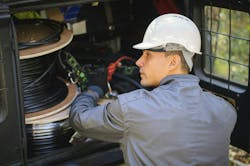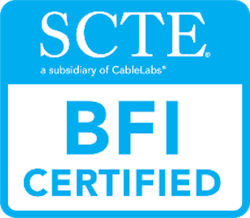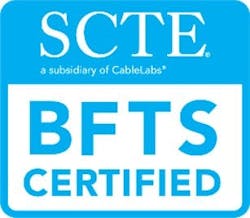A fiber certified workforce
Numerous operator networks are increasingly leveraging fiber optic technology, which requires an agile, well-educated workforce skilled in craft, abilities, and knowledge. The industry consensus is that optical fiber is essential for delivering telecommunication services now, in the future, and for upcoming 10G and beyond platforms. Optical fiber enhances reliability and delivers ultra-fast communications over hybrid fiber-coaxial (HFC), fiber-deep, and fiber-to-the-X (FTTx) networks.
Additionally, digital fiber optics play a role in distributed CCAP architecture (DCA), providing operators with dense multiplexed wavelengths and tools to virtualize the physical and media access control (MAC) layers of access network. Recent industry discussions have also highlighted the imminent arrival of DOCSIS 4.0 over these networks, featuring full duplex (FDX) DOCSIS and extended-spectrum DOCSIS (ESD) solutions up to 1.8 GHz.
Many operators are further investing in their brownfield DOCSIS 3.1 and FTTx networks, such as passive optical networks (PON). Each of these fiber networks demands new and improved workforce skills in care, installation, operations, construction, and engineering. Is your organization prepared to support the optical architectures and technologies of 2025 and beyond?
As a professional installer, technician, engineer, or executive aiming to work with new and existing fiber optic technologies it is crucial for organizations to understand various levels of optics moving forward. Enhancing fiber optic workforce competencies allows for informed decision-making. As an international business partner, SCTE collaborates to keep our members prepared for the latest trends in HFC, FD, 10G, FTTx, DCA/DAA, and DOCSIS through our extensive library of resources.
In addition to our ANSI standards and international chapters, SCTE offers a wide range of development and professional certification courses delivered through a unique industry platform, ensuring that your organization remains at the forefront of technological advancements.
How do you know when it is time to invest in your career or the career of your workforce? Consider asking yourself these questions as part of a self-awareness model:
· Is there a decline in workforce confidence or an increase in employee turnover? Is there low workforce morale?
· Are there more truck rolls and service calls, especially related to installations?
· Is it difficult to find skilled labor?
· Can the workforce effectively compare and contrast technologies, understanding their advantages and disadvantages?
· Are you or your workforce able to explain how an optical distribution network (ODN) operates, is built, tested, measured, and maintained?
· Are less experienced co-workers now your supervisors, or have co-workers stopped seeking your assistance?
· Is your organization being overlooked because your workforce lacks the required fiber skillset and industry credentials, such as SCTE certifications, to operate effectively in the marketplace?
· Are you unfamiliar with the latest optical testing equipment, converged networks, and new installation methods for future architectures?
· Are you or your workforce lacking a formal acknowledgment of your expertise and commitment to your craft?
If you answered "yes" to any of these questions, it is time to invest in the optical skills, knowledge, and abilities of yourself and/or your workforce. According to a survey by LinkedIn, 94% of employees say they would stay longer at a company if they invested in their learning and development (L&D)1. But what is the best program or curriculum to pursue for a career-minded individual or to improve your workforce efficiency?
First, look for a business partner with extensive industry connections and a global perspective on current and future technology. Such a partner will have experience in constructing a comprehensive curriculum in collaboration with industry stakeholders. The curriculum should be based on current job roles, specific tasks, required practical field behaviors, future technologies, and the insight of your business partner. Forward-thinking partners design robust curriculums based on their active role in driving industry specifications (e.g., CableLabs®, IEEE, and ITU), developing emerging standards (e.g., SCTE GAP), and deploying operational best practices (e.g., Wi-Fi Deployment Operational Practices). They also work with industry leadership to solve real-world challenges.
Second, to continually advance workforce competencies and improve employee retention, establish an agile, data-driven learning journey that evolves with industry best practices and standards. Programs should incorporate the latest science in adult learning behaviors, driving business results and delivering a return on investment (ROI). This means the training pays off by reducing truck rolls and calls to the call center.
Third, in the realm of professional certification, telecommunication and information technology (IT) professionals have thousands of certificate and certification programs to choose from. However, despite this variety, many programs are not aligned with current standards and specifications in the telecommunications industry. When certifying workforce skills, key elements and characteristics of a non-profit certification body are essential. Here are a few components of a well-vetted certification program:
· Vendor-Neutral Assessment: A certification body should be an impartial, vendor-neutral evaluation that assesses predetermined industry standards and best practices, ensuring individuals achieve the desired skills, knowledge, and abilities. A professional certification program must follow a rigorous development process and be psychometrically sound.
o Employers may use professional certifications to measure and drive competencies, improving workforce performance to a level of expertise.
o Professional certifications are not designed to teach but provide crucial data for teachable moments and identify competency gaps.
· Clear Program Goals: A certification program should have clear goals, objectives, society bylaws, and standards developed by industry experts. A professional certification program should build an entire career ecosystem.
· Distinct from End-of-Course Certificates: A certification is not simply an end-of-course certificate nor is it awarded after completing set courses in a curriculum. Certifications measure skills, knowledge, and abilities, requiring a separate assessment.
o In survey data from Microsoft, 91% of hiring managers consider certification as part of their hiring criteria2. In addition, 91% believe IT certifications are valuable in validating expertise2.
· Non-Profit Organizations: Many credible certification organizations are non-profit, reinvesting in the latest L&D tools and assets to drive business results. A certification program should be administered through an L&D certification committee of industry subject matter experts (SMEs).
· Ongoing Maintenance and Renewal: Professional certification programs offer credits (e.g., SCTE recertification units [RUs]) to maintain and renew certification to industry standards every 3 to 5 years. Programs should align with industry-approved curricula.
In the field of fiber optics, several certification options are available to telecommunications professionals. One organization that stands out for architecting professional certifications and curricula with all the above key elements and characteristics is SCTE, a subsidiary of CableLabs. Dedicated to the telecommunications industry, the SCTE offers a unique approach to telecommunications education. As a telecommunications professional, you can feel confident that you are acquiring the necessary industry skills while maximizing your career potential.
For over 50 years, the SCTE has been a leader in developing telecommunications resources to meet the ongoing requirements of operations and engineering. Special attention has been given to incorporating real-world skills and abilities into their educational platform, known as SCTE VirtuLearn™.
To efficiently invest in yourself or your workforce, consider the SCTE's optical certification exams, which encompass the competencies of other popular programs in the marketplace but at a fraction of the cost.
The SCTE has designed its program to be the most comprehensive single-solution fiber program in the marketplace. An installer or technician who completes the SCTE Broadband Fiber Installer (BFI) course or equivalent training with field experience is well-prepared to take the industry-recognized SCTE BFI professional certification exam, as well as several additional assessments offered by other organizations.
The SCTE Broadband Fiber Transport Specialist (BFTS), recently updated with new industry best practices, also equips the workforce for various certification assessments.
As a bonus, both Viavi and Corning have endorsed the SCTE fiber professional certifications! According to a study by CompTIA, 72% of professionals believe certifications have improved their professional development and career advancement opportunities within their organizations3. Both the SCTE BFI and SCTE BFTS provide a variety of educational delivery models, including online, onsite practical instructor-led, and hybrid options. The SCTE BFI and the SCTE BTS are available in Spanish. Additionally, a customized enterprise licensing curriculum can be constructed, making it easier than ever to prepare for 2025 and beyond.
One thing is clear: the numerous transformations in the telecommunication network will require individuals and operators to advance their skills, knowledge, and abilities. A key emerging requirement for many operators will be finding new talent and retaining existing talent. In our SCTE L&D return on investment (ROI) white paper, we highlight that many employees consider training and development (e.g., professional certification) opportunities as crucial factors for staying with their employer. As you plan for the future of your career or the careers of others, be sure to invest in yourself and/or your workforce, aiming to complete a few professional certifications along the way. Learn more at SCTE.org/education/certification/professional-certifications.
3. https://connect.comptia.org/content/research/hr-perceptions-of-it-training-and-certification
Steven R. Harris is the Vice President, Global Market Development for the Society of Cable Telecommunications Engineers (SCTE®), a subsidiary of CableLabs®.





